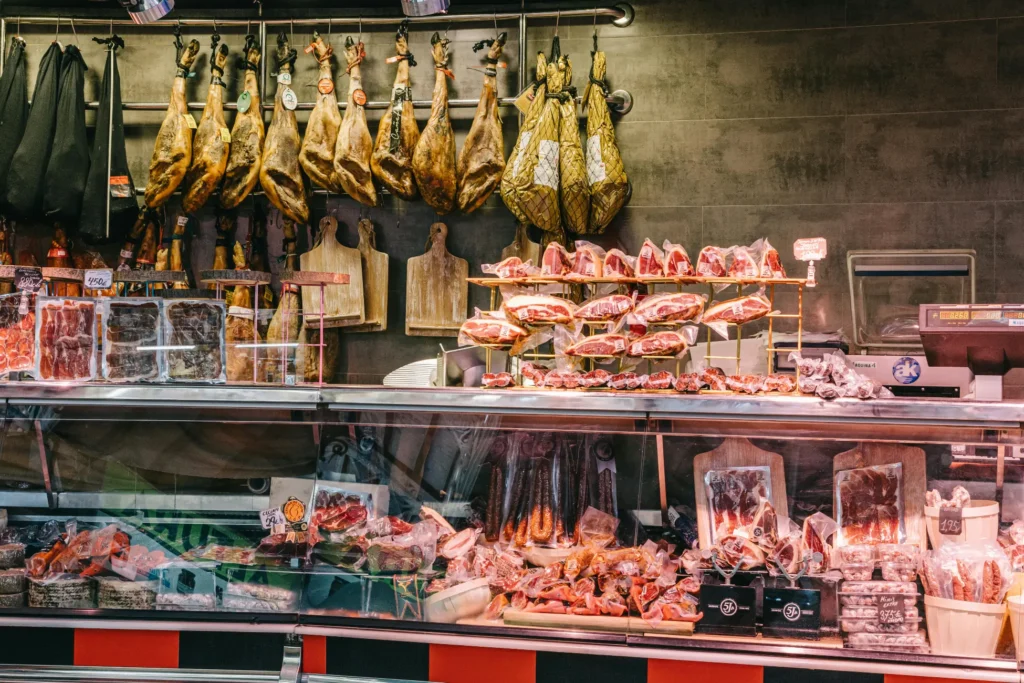Spanish dishes, the best traditional food
Spanish dishes, the best traditional food
Spanish dishes, the best traditional food
Spanish dishes, the best traditional food
8. September 2024
Feedback: 0
For food lovers, Spain is a true paradise. Food plays a huge role in the culture there. Spanish cuisine has so much to offer: an impressive variety of flavors, textures, and ingredients that vary from region to region. In this article, we’ll introduce you to some of the most famous and traditional Spanish dishes that you absolutely shouldn’t miss when visiting the country – or maybe even try making yourself!
- Paella – the most famous Spanish dish
- Tortilla Española – the Spanish Potato Omelette
- Jamón Ibérico – the King of Ham
- Gazpacho – the Cold Soup from Andalusia
- Patatas Bravas – the Classic Tapas
- Pulpo a la Gallega – Galician Style Octopus
- Churros con Chocolate – the Spanish Breakfast Delight
- Croquetas – Creamy Bites with Various Fillings
- Conclusion
Paella – the most famous Spanish dish
When you think of Spanish food, Paella is probably the first thing that comes to mind. This world-famous dish originally comes from Valencia and is a true symbol of Spanish gastronomy. Typically, Paella is made with rice, saffron, and plenty of seafood like shrimp, mussels, and squid. However, there’s also Paella Valenciana, which includes chicken, rabbit, and sometimes even snails. The key to a perfect Paella is cooking the rice so that it absorbs the flavors of all the other ingredients.
💡 Tip 💡
If you’re in Spain, try Paella at lunchtime. It’s rarely served in the evening since it’s considered a rather heavy dish.
Tortilla Española – the Spanish Potato Omelette
The Tortilla Española, also known as Tortilla de Patatas, is a simple yet incredibly delicious dish that you can find in every bar or restaurant in Spain. The basic recipe primarily consists of potatoes, eggs, and onions. In some regions, the onions are omitted.
Making a perfect Tortilla isn’t entirely easy, as the potatoes need to be evenly soft, and the eggs must be cooked well but still juicy. Tortilla Española can be served hot or cold, and it’s perfect as a tapas dish, snack, or even a main course.
💡Tip 💡
Try to sample different variations of the Tortilla in Valencia or Madrid – each region has its own little secrets.
Jamón Ibérico – the King of Ham
Jamón Ibérico is one of Spain’s culinary highlights. This ham is made from a special breed of pig known as the Ibérico pig. These animals are raised in specific regions of Spain. What makes this ham so special is not only the tender meat but also the long aging process. Over time, the ham only gets better.
There are different qualities of Jamón Ibérico, with the best being Jamón Ibérico de Bellota. These pigs are fed acorns, which give the ham its distinctive nutty flavor.
💡 Tip 💡
In many Spanish bars, Jamón Ibérico is freshly sliced from the leg and served as a tapa with some bread. You absolutely must try it!
Gazpacho – the Cold Soup from Andalusia
The hot Spanish summer brings refreshing dishes like Gazpacho. This cold soup originally comes from Andalusia and is made from ripe tomatoes, peppers, cucumbers, onions, garlic, olive oil, and vinegar. The ingredients are blended together to a creamy consistency and then served chilled.
Gazpacho is perfect for summer and is often served as a starter or light meal. An interesting variant of Gazpacho is Salmorejo, which is a thicker version of the soup garnished with chopped ham and hard-boiled eggs.
💡 Tip 💡
If you’re in Andalusia, order a glass of Gazpacho to cool off on a hot day – it’s often served in glasses for drinking!
Patatas Bravas – the Classic Tapas
Patatas Bravas are crispy fried potato chunks served with a spicy tomato sauce and often accompanied by aioli. This simple yet incredibly delicious dish can be found as a tapa in almost every Spanish bar. The preparation of Patatas Bravas can vary significantly by region. In Madrid, the sauce is often spicy, while in other regions it tends to be milder.
💡 Tip 💡
Try Patatas Bravas with a glass of Spanish wine or a refreshing beer – they make the perfect companion to an early evening drink.
Pulpo a la Gallega – Galician Style Octopus
If you enjoy Spanish cuisine, I highly recommend the dish “Pulpo a la Gallega.” This dish originates from Galicia, a region in the northwest of Spain known for its excellent cuisine. First, the octopus is boiled, then sliced and seasoned with paprika, salt, and olive oil. Traditionally, it is served on a wooden board.
The octopus is incredibly tender and juicy. Combined with the spicy paprika and fine olive oil, it creates a truly special flavor combination.
💡 Tip 💡
You can often find Pulpo a la Gallega at local festivals and markets – a great opportunity to enjoy the dish in an authentic setting.
Churros con Chocolate – the Spanish Breakfast Delight
Churros are fried dough sticks that are crispy on the outside and wonderfully soft on the inside. Traditionally, they are eaten for breakfast or as an afternoon snack, accompanied by thick, hot chocolate for dipping. Especially in the colder months, this is a popular dish for a quick treat.
In Spain, there are various variations of churros: in Madrid, they are long and thin, while in other regions, they are shorter and thicker. The chocolate served with them is usually very rich and thick.
💡Tip 💡
If you’re in Spain, visit a „Churrería“ and enjoy churros with hot chocolate – a perfect start to the day or a sweet snack in between!
Croquetas – Creamy Bites with Various Fillings
Croquetas are also a very popular tapas dish that you can find in almost every Spanish bar. These small, fried balls are crispy on the outside and creamy on the inside. They can be filled with a variety of ingredients, such as ham, chicken, fish, or cheese.
The base of the filling is a thick béchamel sauce, which gives the croqueta its creamy texture. Croquetas are not only delicious but also make a great snack on the go.
💡 Tip 💡
Try different varieties of croquetas in Spain – each region has its own specialties.
Conclusion
Spanish cuisine is as diverse as the country itself. Whether you enjoy a hearty paella on the beach in Valencia or simple tapas in a small bar in Madrid, each dish offers a unique experience. If you travel to Spain, be sure to take the opportunity to try as many traditional Spanish dishes as possible. This way, you can experience the culture and the passion of the people for good food up close. If you can’t travel to Spain, why not try making one of these dishes at home?
We hope these tips help you master your expat everyday life even better! Do you have your own experiences or further recommendations on the topic of moving abroad? Feel free to leave us a comment! Share this post with others who could benefit from the tips, and stay tuned for more inspiration from life as an expat.
Yours, Steffi & Marius

Wir sind zwei deutsche Auswanderer und auf emigres-life nehmen wir Dich mit auf unsere Reise in ein neues Leben.
In unserem Projekt schwingt das Pendel meist in Richtung stressig oder chaotisch und weniger in Richtung tiefenentspannt.
Wenn du also wissen willst, in welches Fettnäpfchen wir als nächstes treten oder welche Hürden vor uns liegen und wie wir sie überwinden, dann bleib dran.



 Pin it!
Pin it!

